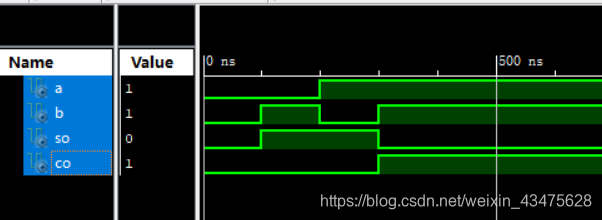还是以38译码器为例子
vhdl常用的语法无非就
用在进程下边:
1.if-else-elsif-end if;
2. case x is
when " “=>b<=” “;
when others=>b<=“Z”;
end case;
用在结构体下
1.a<=” “when b=” " else
" “when b=” "else
“Z”;
2 with a select
" " when " ",
" " when " ",
" "when others;
下边还是以38译码器为例
1.用conv_integer做
一定要加unsigned包
代码:
--ujs-lili;
library IEEE;
use IEEE.STD_LOGIC_1164.ALL;
use IEEE.STD_LOGIC_unsigned.ALL;
entity my3_8 is
port(a:in std_logic_vector(2 downto 0);
b:out std_logic_vector(7 downto 0));
end my3_8;
architecture Behavioral of my3_8 is
begin
process(a)
begin
b<=(others=>'1');
b(conv_integer(a))<='0';
end process;
end Behavioral;
如果这个conv_integer不放在process中的话。b是不会出来正确结果的
2.when-else
放在结构体下面
--ujs-lili
library IEEE;
use IEEE.STD_LOGIC_1164.ALL;
entity my3_8_2 is
port(a : in std_logic_vector(2 downto 0);
b : out std_logic_vector(7 downto 0));
end my3_8_2;
architecture Behavioral of my3_8_2 is
begin
b<="11111110"when a="000" else
"11111101" when a="001" else
"11111011" when a="010" else
"11110111" when a="011" else
"11101111" when a="100" else
"11011111" when a="101" else
"10111111" when a="110" else
"01111111" when a="111" else
"ZZZZZZZZ";
end Behavioral;
3.with-select
放在结构体下边,其实和when-else 差不多
--ujs-lili
library IEEE;
use IEEE.STD_LOGIC_1164.ALL;
entity my38_3 is
port(a:in std_logic_vector(2 downto 0);
b:out std_logic_vector(7 downto 0));
end my38_3;
architecture Behavioral of my38_3 is
begin
with a select
b<="11111110"when "000" ,
"11111101" when "001" ,
"11111011" when "010" ,
"11110111" when "011" ,
"11101111" when "100" ,
"11011111" when "101" ,
"10111111" when "110" ,
"01111111" when "111" ,
"ZZZZZZZZ" when others;
end Behavioral;
就改了几个地方,1.with-select语句,2去掉else,变“,”。3.when others。
4.case
放在process中
--ujs-lili
library IEEE;
use IEEE.STD_LOGIC_1164.ALL;
entity my38_4 is
port(a : in std_logic_vector(2 downto 0);
b : out std_logic_vector(7 downto 0));
end my38_4;
architecture Behavioral of my38_4 is
begin
process(a)
begin
case a is
when "000"=>b<="11111110";
when "001"=>b<="11111101";
when "010"=>b<="11111011";
when "011"=>b<="11110111";
when "100"=>b<="11101111";
when "101"=>b<="11011111";
when "110"=>b<="10111111";
when "111"=>b<="01111111";
when others=>b<="ZZZZZZZZ";
end case;
end process;
end Behavioral;
说明:以上代码都是经过仿真的
下面再做一个10进制加法计数器
功能:异步复位,上升沿加一
--ujs_lili
library IEEE;
use IEEE.STD_LOGIC_1164.ALL;
use IEEE.STD_LOGIC_unsigned.ALL;--这个一定要有
use IEEE.STD_LOGIC_arith.ALL;--这里可以不用的,你用*才要这个
entity shijinzhi is
port(en,clk:in std_logic;
rst: in std_logic;
a:out std_logic_vector(3 downto 0));
end shijinzhi;
architecture Behavioral of shijinzhi is
signal a1: std_logic_vector(3 downto 0):="0000";
begin
process(clk,rst)
begin
if rst='1' then
a1<="0000";--如果你不是写的a1,仿真就会错,但是a1不会错
elsif clk'event and clk='1' then
if a1 = "1001" then
a1<="0000";
else
a1<=a1+'1';
end if;
end if;
end process;
a<=a1;
end Behavioral;
仿真
如果if …a<=“0000”;
正确:
下面再做一个四位二进制的加法器
先弄清楚什么是半加器
就是两个二进制数相加,然后理论上说
0 0 0
0 1 1
1 0 1
1 1 2 那我们都知道2是不对的,此时的结果在半加器的输出是0,进位是1,就像微机原理中的溢出一样。
这就,诞生了全加器,其实就是带进位的半加器

s=a异或b异或c0;
ci=ab+(a异或b)与cin;
首先得搞明白什么是四位二进制的加法器
半加器:
library IEEE;
use IEEE.STD_LOGIC_1164.ALL;
entity banjiaqi is
port (a,b : in std_logic;
so,co: out std_logic);
end banjiaqi;
architecture Behavioral of banjiaqi is
begin
so<=a xor b;--逻辑运算之间是不可以用加
co<=a and b;
end Behavioral;
为什么两个半加器加一个与门可以得到一个全加器呢?
你看半加器的输出
so=ain xor bin;
co= ain and bin;
你看全加器的输出
so=ain xor bin xor cin;
co= ain and bin +(ain xor bin )and cin ;
你应该可以看出来只要把第一个半加器的so和cin作为第二个半加器的输入
那么第二个半加器的输出为:
so=ain xor bin xor cin;
co=(ain xor bin )and cin ;
最后再加一个和第一个半价器的co=ain and bin;或门相连ok
仿真:
代码:
--半加器
library IEEE;
use IEEE.STD_LOGIC_1164.ALL;
entity banjiaqi is
port (a,b : in std_logic;
so,co: out std_logic);
end banjiaqi;
architecture Behavioral of banjiaqi is
begin
so<=a xor b;--逻辑运算之间是不可以用加
co<=a and b;
end Behavioral;
--一位全加器
library IEEE;
use IEEE.STD_LOGIC_1164.ALL;
use IEEE.STD_LOGIC_unsigned.ALL;
entity yiweiquanjia is
port(a,b,cin:in std_logic;
cout: out std_logic;
sum: out std_logic);
end yiweiquanjia;
architecture Behavioral of yiweiquanjia is
component banjiaqi is
port (a,b : in std_logic;
so,co: out std_logic);
end component;--切记
signal n,m,k :std_logic;
begin
u1:banjiaqi port map
(a=>a,b=>b,so=>m,co=>n);
u2:banjiaqi port map
(a=>cin,b=>m,so=>sum,co=>k);
cout<=k or n;--切记
end Behavioral;
rtl电路:
下面开始四位二进制加法器
就是两个4位的输入,一个进位,然后输出4位结果,输出进位
library IEEE;
use IEEE.STD_LOGIC_1164.ALL;
use IEEE.STD_LOGIC_unsigned.ALL;
entity siweijiaafaqi is
port(a,b : in std_logic_vector(3 downto 0);
cin:in std_logic;
sum: out std_logic_vector(3 downto 0);
cout: out std_logic);
end siweijiaafaqi;
architecture Behavioral of siweijiaafaqi is
signal aa,bb,sum1: std_logic_vector(4 downto 0);
begin
aa<='0'&a;
bb<='0'&b;
sum1<=aa+bb+cin;
sum<=sum1(3 downto 0);
cout<=sum1(4);
end Behavioral;仿真:






